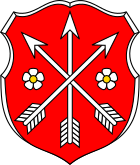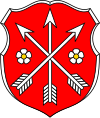Sulzfeld am Main
| coat of arms | Germany map | |
|---|---|---|

|
Coordinates: 49 ° 42 ' N , 10 ° 8' E |
|
| Basic data | ||
| State : | Bavaria | |
| Administrative region : | Lower Franconia | |
| County : | Kitzingen | |
| Management Community : | Kitzingen | |
| Height : | 202 m above sea level NHN | |
| Area : | 7.68 km 2 | |
| Residents: | 1259 (Dec. 31, 2019) | |
| Population density : | 164 inhabitants per km 2 | |
| Postal code : | 97320 | |
| Area code : | 09321 | |
| License plate : | KT | |
| Community key : | 09 6 75 170 | |
| LOCODE : | DE QP9 | |
| Community structure: | 1 district | |
| Association administration address: | Friedrich-Ebert-Strasse 5 97318 Kitzingen |
|
| Website : | ||
| Mayor : | Matthias Dusel (Sulzfeld municipal list) | |
| Location of the community Sulzfeld a.Main in the district of Kitzingen | ||

Sulzfeld am Main (officially: Sulzfeld a.Main ) is a municipality in the Lower Franconian district of Kitzingen and a member of the Kitzingen administrative community .
geography
Geographical location
The place is located in the southern Maindreieck between Kitzingen and Ochsenfurt . Sulzfeld a. Main can be easily reached via the A7, A3 and the Kitzingen train connection. Hiking and cycling trails in the neighboring communities are very well developed. The Franconian Marienweg runs through Sulzfeld .
Community structure
Sulzfeld am Main has only one district.
Neighboring communities
Neighboring communities are (clockwise from the north): Kitzingen , Marktsteft , Segnitz , Frickenhausen am Main and Ochsenfurt .
Natural location
Sulzfeld and its district are located in two natural areas, both of which are part of the main unit group Mainfränkische Platten . The place itself is located in the low-precipitation Kitzinger Main Valley , the district protrudes into the higher plateaus in the southern Main Triangle .
history
Until 2014 it was believed that Sulzfeld's first documented mention came from the year 915. However, this turned out to be wrong, which is why a large 1100-year celebration that had already been planned for 2015 was canceled by the local council. The oldest evidence of the existence of Sulzfeld is now a church forgery from the year 1007. On August 8, 1266, the Cyriakus battle, one of the great knight battles of the Middle Ages, took place in front of the site. During the Thirty Years War Sulzfeld was plundered twice by the Swedes, so that in 1648 the place only had 59 citizens and 7 widows. In 1796 the place was sacked by French revolutionary troops. After the secularization of 1803 and the turmoil of the Napoleonic Wars , the ownership of the bishopric, which belonged to the Franconian Empire , finally became part of the Kingdom of Bavaria in 1814 after brief membership of the Grand Duchy of Würzburg .
politics
mayor
Matthias Dusel (Sulzfelder Kommunale Liste - SKL) has been mayor since May 1, 2020; he was elected on March 15, 2020 with 63.9% of the vote.
His predecessor, with a term of office of 36 years (May 1, 1984 to April 30, 2020), was Gerhard Schenkel (* 1955), nominated by the Sulzfeld Municipal List , in which the CSU, Greens, UFCW and independent personalities are involved. Schenkel, who was elected six times, last prevailed on March 16, 2014 with 59.23% of the votes against the candidate from the electoral community pro Sulzfeld .
Municipal council
The mayor and twelve full members belong to the municipal council. Since May 2020 the Sulzfeld municipal list (SKL / CSU / UFCW / GRÜNE / independent personalities) has seven municipal council members and the voter community pro Sulzfeld (WPS) five municipal councils. In the term of office from May 2014 to April 2020, due to the local elections on March 16, 2014, both groups each provided six municipal councils. The WPS was founded in the spring of 2013 as a non-party group.
coat of arms
| Blazon : "Three crossed arrows in red, accompanied by two silver heraldic roses with golden tassels." | |
| Foundation of the coat of arms: For the first time, the figures of today's coat of arms were depicted on a seal from the 17th century. The colors red and silver refer to the affiliation to the former bishopric of Würzburg. |
Culture and sights
The village has almost completely preserved medieval fortifications with 21 towers. It has also largely preserved its late medieval appearance. Sulzfeld is also known as a Franconian wine town; well-known locations are the Sulzfelder Cyriakusberg and the Sulzfelder Mouse Valley . Sulzfeld is also considered the birthplace of the meter bratwurst , a variant of the Franconian bratwurst. In a local inn, the consumption record is over six meters. The landlord assures: "Whoever breaks this record has all consumption costs free".
The Catholic parish church of St. Sebastian still forms the center of the old town . Today's church was built at different times, the tower was increased at the beginning of the 17th century under the rule of the Würzburg prince-bishop Julius Echter von Mespelbrunn. The cross chapel was also built on the site of the cemetery in the 18th century.
Until the second half of the 20th century, there was a ferry connection across the Main in Sulzfeld am Main. The ferry was first mentioned in the 14th century. However, the ferry was always exposed to competition from the nearby ferry in Marktsteft. In the early modern period, the ferry was therefore temporarily abandoned. It was not until 1955 that the municipality of Sulzfeld am Main acquired the ferry rights from Marktsteft.
In 2009 the place became district and state winner in the competition "Our village has a future - our village should be more beautiful" and was awarded gold medals. At the federal decision in 2010, the place was awarded the silver medal among the 30 most beautiful places in Germany.
High water marks at the city gate
Viticulture
Today Sulzfeld is an important wine-growing area in the Franconian wine-growing region . There are a total of three vineyards around the village; the wine has been marketed under the names Sulzfelder Cyriakusberg, Sulzfelder Mouse Valley and Sulzfelder Sonnenberg since the 1970s. Sulzfeld am Main is part of the area Main south until 2017, the wineries in the area were Maindreieck summarized. The shell limestone soils with Keuper admixtures around Sulzfeld are just as suitable for growing wine as the location in the Maingau climate zone, which is one of the warmest in Germany.
The people around Sulzfeld have been involved in viticulture since the early Middle Ages . The Franconian settlers probably brought the vine to the Main in the 7th century. In the Middle Ages, the region was part of the largest contiguous wine-growing region in the Holy Roman Empire. The people mostly operated part-time viticulture for self-sufficiency , at the same time export centers were already emerging, especially along the Main.
As early as the Middle Ages, Sulzfeld rose to become one of the most important wine-growing communities of the Würzburg monastery , which was also reflected in the establishment of the fortifications and a representative cellar for storing the drink. The attack by the Swedes in the Thirty Years' War in 1631 began during the grape harvest, so that almost the entire harvest was destroyed. As a result, the village became impoverished because it lived largely from exporting wine.
Viticulture experienced a major decline after secularization at the beginning of the 19th century. Above all, locations with less favorable climatic conditions were completely abandoned. In addition, the emergence of pests such as phylloxera made cultivation difficult . In Sulzfeld, the full-time, "after-work" winemakers became. The Franconian wine-growing region was not able to consolidate again until the second half of the 20th century. The use of fertilizers and improved cultivation methods had contributed to this, as had the organization in cooperatives and the land consolidation of the 1970s.
Together with cultural tourism, which aims in particular for the completely preserved Altort, viticulture is an important industry in Sulzfeld today. Several wineries have their headquarters in the village. In addition, the Sulzfeld vineyard in Mouse Valley has been declared a major location by the Association of German Predicate and Quality Wineries (VDP). A grape variety hiking trail runs through the vineyards around Sulzfeld. The centuries-old wine culture shapes the place all year round. The focus is the street wine festival at the beginning of August; it has been celebrated for over 50 years.
| Vineyard | Size 1993 | Size 2019 | Compass direction | Slope | Main grape varieties | Great location |
|---|---|---|---|---|---|---|
| Cyriakusberg | 120 ha | 117 ha | South, southeast | 10-45% | Silvaner , Müller-Thurgau | Kitzinger Councilor |
| Mouse valley | 60 ha | 60 ha | South southeast | 25-45% | Müller-Thurgau , Silvaner | Kitzinger Councilor |
| Sonnenberg | not clear | not clear | not clear | not clear | Müller-Thurgau | Kitzinger Hofrat , free of large areas |
Personalities
Sons and daughters of the church
- Johannes Finck (* around 1440; † after 1505), among other things doctor in Würzburg, city doctor of Amberg and episcopal personal doctor in Eichstätt
- Johann Hartmann (* around 1550; † 1622), official cellar in Miltenberg
- Candidus Pfister († 1704), Abbot of Ebrach Monastery
- Konrad Schweser (1899–1975), builder and Righteous Among the Nations
Connected with Sulzfeld
- Hans Hartmann (1863–1942), politician of the DDP, died in Sulzfeld
literature
- Hans Ambrosi, Bernhard Breuer: German Vinothek: Franconia. Guide to the vineyards, winegrowers and their kitchens . Herford 2 1993.
- Hans Bauer: Old and new coats of arms in the Kitzingen district . In: Yearbook of the district of Kitzingen 1980. In the spell of the Schwanberg . Kitzingen 1980. pp. 53-70.
- Franz Zach: Sulzfeld am Main . In: District Administrator and District Council of the District of Kitzingen (ed.): District of Kitzingen . Münsterschwarzach 1984. pp. 541-544.
Web links
- sulzfeld-main.de
- Entry on the coat of arms of Sulzfeld am Main in the database of the House of Bavarian History
Individual evidence
- ↑ "Data 2" sheet, Statistical Report A1200C 202041 Population of the municipalities, districts and administrative districts 1st quarter 2020 (population based on the 2011 census) ( help ).
- ↑ http://www.bayerische-landesbibliothek-online.de/orte/ortssuche_action.html ? Anzeige=voll&modus=automat&tempus=+20111114/175452&attr=OBJ&val= 1674
- ↑ Ralf Weiskopf: No celebration without a certificate. Mainpost, Würzburg, October 17, 2014 http://www.mainpost.de/regional/wuerzburg/Urkunden;art779,8383435
- ↑ Hans Michael Hensel: A document is also forged. Monks falsified foundation deeds in favor of the church. November 11, 2014 http://www.hmhensel.com/1000-jahre-sulzfeld-aber-niemand-feiert/
- ↑ Local councils and mayors , accessed on June 28, 2020
- ^ Bauer, Hans: Old and new coats of arms in the district of Kitzingen . P. 68.
- ^ Zach, Franz: Sulzfeld am Main . P. 542.
- ^ Ambrosi, Hans (among others): German Vinothek: Franconia . Pp. 50-52.
- ^ Sulzfeld am Main: Tourism and Wine , accessed on June 1, 2019.
- ^ Government of Lower Franconia: Vineyards in Bavaria broken down by area , PDF file, accessed on May 16, 2019.
- ^ Ambrosi, Hans (among others): German Vinothek: Franconia . P. 237.
- ^ Wolfgang Wegner: Finck (Vinck), Johannes. In: Werner E. Gerabek , Bernhard D. Haage, Gundolf Keil , Wolfgang Wegner (eds.): Enzyklopädie Medizingeschichte. De Gruyter, Berlin / New York 2005, ISBN 3-11-015714-4 , p. 401.














